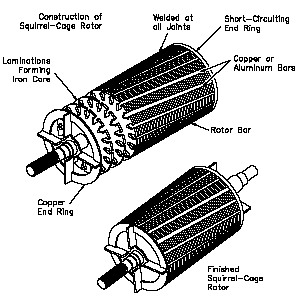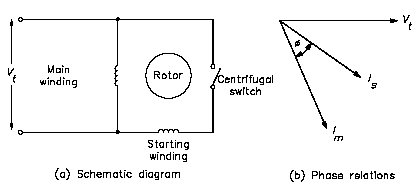AC Induction Motor Application and Operation
Industrial Electric Motors and Generators Menu
The AC Alternating Current Induction Motor is the most commonly used AC motor in industrial applications because of its simplicity, rugged construction, and relatively low manufacturing costs. The reason that the AC induction motor has these characteristics is because the rotor is a self-contained unit, with no external connections. This type of motor derives its name from the fact that AC currents are induced into the rotor by a rotating magnetic field.

The AC induction motor rotor (Illustrated above) is made of a laminated cylinder with slots in its surface. The windings in the slots are one of two types.
The most commonly used is the "squirrel-cage" rotor. This rotor is made of heavy copper bars that are connected at each end by a metal ring made of copper or brass. No insulation is required between the core and the bars because of the low voltages induced into the rotor bars. The size of the air gap between the rotor bars and stator windings necessary to obtain the maximum field strength is small.
Single-Phase AC Induction Motors
If two stator windings of unequal impedance are spaced 90 electrical degrees apart and connected in parallel to a single-phase source, the field produced will appear to rotate. This is called phase splitting.
In a split-phase motor, a starting winding is utilized. This winding has a higher resistance and lower reactance than the main winding (illustration shown below). When the same voltage VT is applied to the starting and main windings, the current in the main winding (IM) lags behind the current of the starting winding IS (illustration shown below ). The angle between the two windings is enough phase difference to provide a rotating magnetic field to produce a starting torque. When the motor reaches 70 to 80% of synchronous speed, a centrifugal switch on the motor shaft opens and disconnects the starting winding.
Single-phase motors are used for very small commercial applications such as household appliances and buffers.
